Building bigger quads doesn’t require fancy tricks—just the right exercises organised into an effective quad-focused leg day.
If your leg day isn’t producing the quad growth you want, it’s time for a strategic shift.
Your problem is likely that your leg routine scatters focus across too many muscle groups. As a result, your quads get too little attention and their growth stalls.
But a quad-focused leg day—containing only the most effective quad-strengthening exercises—can change that.
By zeroing in on the very best exercises for building quad mass, you can quickly build the thick, teardrop quads you’ve always wanted. In my experience working with tens of thousands of people, these are the exercises that consistently deliver the best results:
- Barbell back squat
- Barbell front squat
- Bulgarian split squat
- Dumbbell lunge
- Leg press
- Hack squat
- Dumbbell step-up
- Dumbbell split squat
- Goblet squat
- Sissy squat
- Bodyweight squat
- Leg extension
In this article, you’ll discover why these exercises are so effective, learn how to perform them with proper form, understand how to incorporate them into effective quad-focused leg day workouts, and more.
Want to know exactly how you should train to reach your fitness goals? Take our free 60-second training quiz and find out now.
Key Takeaways
- The quadriceps femoris—or “quads”—are a group of four muscles on the front of the upper leg comprising the rectus femoris, vastus lateralis, vastus medius, and vastus intermedius.
- Exercises involving hip flexion tend to activate the upper quads more, whereas those that focus on knee extension train the lower quads better.
- To accelerate your gains while following a quad-focused leg day routine, consider using a high-quality protein powder to help you reach your daily protein target, creatine to support recovery and muscle growth, and a pre-workout to enhance energy, focus, and performance.
- Building bigger quads balances your physique, enhancing athletic performance, and helps prevent injuries.
- The most effective quad exercise is any form of compound squat. To fully develop all parts of your quads, however, you also need to do quad isolation exercises where your hips remain stationary, like the leg extension or sissy squat.
Table of Contents
+
Quad Anatomy
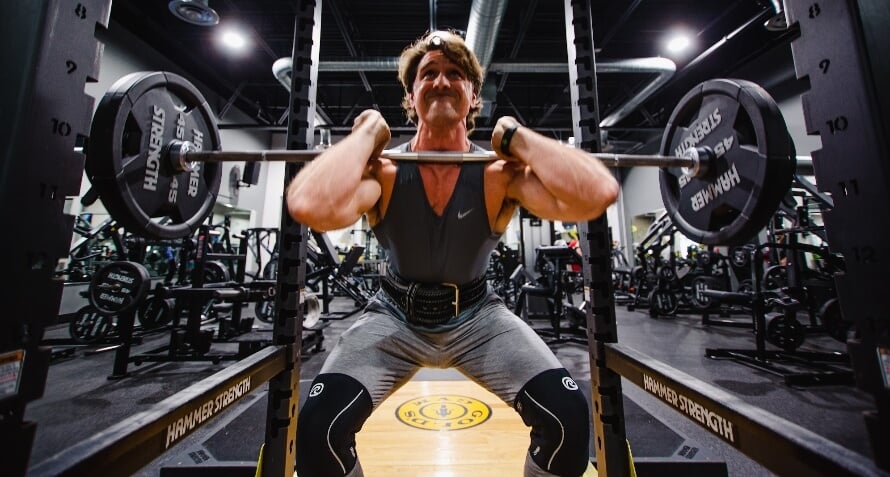
The quadriceps femoris—or “quads”—are a group of four muscles on the front of the upper leg:
-
- Rectus femoris
- Vastus lateralis
- Vastus medialis (which includes the vastus medialis oblique, or “VMO”)
- Vastus intermedius
Together the quads extend (straighten) the knees and flex the hips (bring your thighs toward your abdomen).
Here’s how they look:
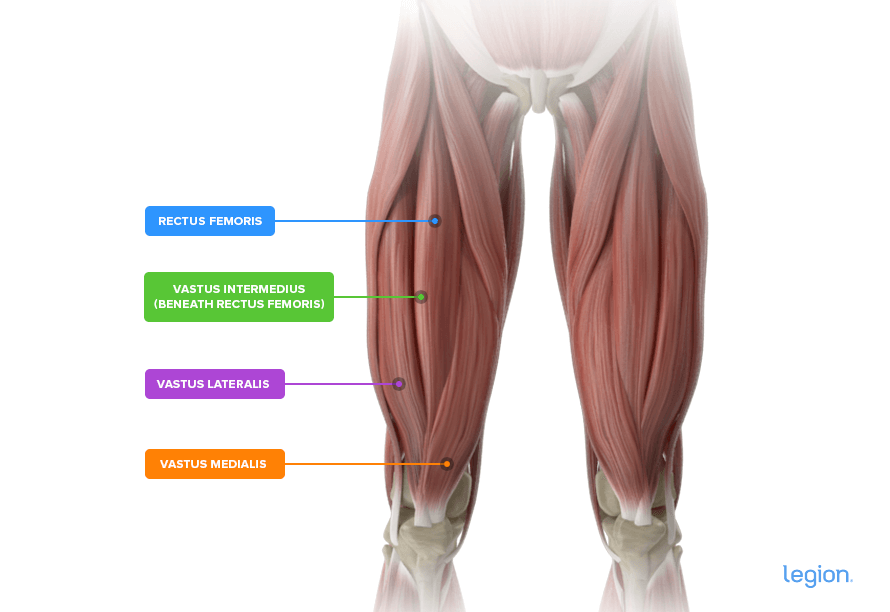
Can You Target Different Parts of the Quads?
Yes—some exercises are better for training the upper quads, while others emphasize the lower quads.
Research suggests that exercises involving hip flexion (bringing the thigh toward the chest), like squats and lunges, tend to activate the upper (proximal) quads more.
In contrast, exercises that focus on knee extension (straightening the knee), like leg extensions and sissy squats, tend to hit the lower (distal) quads harder.
These “regional activation” patterns also show up in dynamic activities like walking and cycling, which suggests that certain movements do slightly favor one region over another.
In practice, this means compound quad exercises may be slightly better upper quad exercises, while quad isolation exercises are probably better lower quad exercises.
What doesn’t seem to matter much is stance width and orientation. Several studies show that muscle activation in your legs is the same regardless of how wide you set your feet or how you point your toes.
In other words, tinkering with these variables probably won’t matter much when it comes to growth. Still, it’s something you should experiment with to find a stance that feels most comfortable for you.
The 12 Best Exercises for A Killer Quad-Focused Leg Day
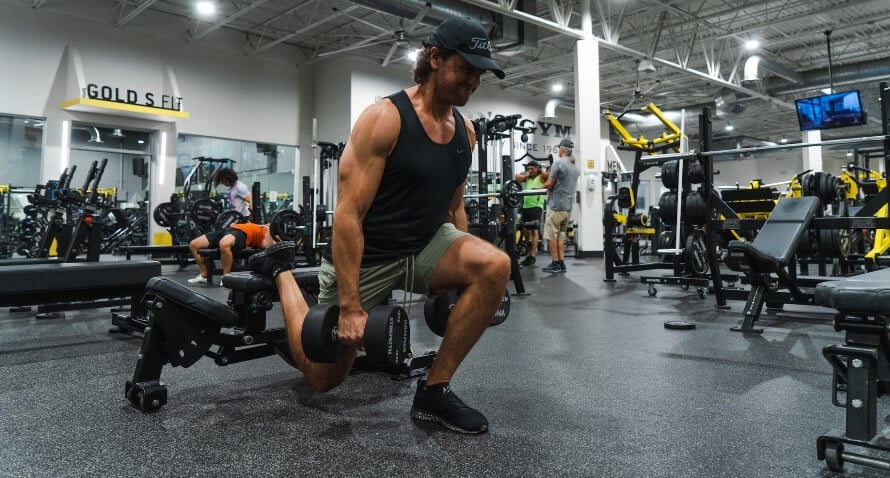
These are the 12 best exercises for building quad size and strength. Here’s how to perform each exercise, why they’re the best, and how to integrate them into your routine with guidance on sets, rep ranges, and rest periods.
1. Barbell Back Squat

Why: The barbell back squat is the king of free-weight quad exercises because it trains the quads through a long range of motion and allows you to lift heavy weights safely and progress regularly, which are vital for building quad mass and strength.
How to:
- Position a barbell in a squat rack at about the height of your nipples.
- Step under the bar, pinch your shoulder blades together, and rest the bar above the bony ridges on the bottom of your shoulder blades.
- Lift the bar out of the rack, take 1-to-2 steps backward, and place your feet a little wider than shoulder-width apart with your toes pointing slightly outward.
- Keeping your back straight, sit down and push your knees out in the same direction as your toes.
- Stand up and return to the starting position.
Sets and reps: 3 sets | 4-to-6 reps | 3-to-5 min rest
READ MORE: How to Do the Back Squat: Form, Benefits, and More
2. Barbell Front Squat
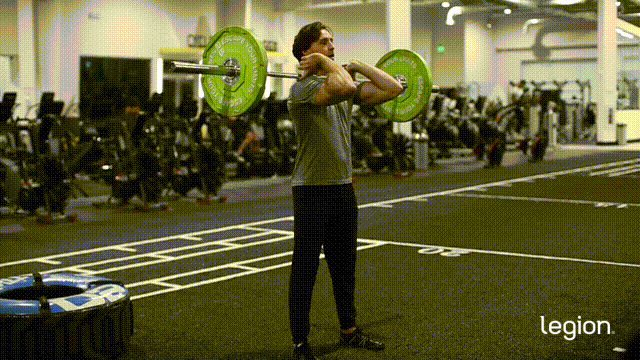
Why: The front squat is another key compound quad exercise that trains the quads as effectively as the back squat, even with ~20% less weight. It also places significantly less compressive forces on your knees and lower back, making it an excellent choice for those aiming to build quad mass while minimizing strain on these areas.
How to:
- Position a barbell in a squat rack at about the height of your breastbone.
- Grab the bar with a shoulder-width grip and your palms facing away from you.
- Step closer to the bar so that it presses against the top of your breastbone and push your elbows up and out in front of the bar.
- With the bar resting on the front of your shoulders and held in place by your hands, lift it out of the rack, take 1-to-2 steps backward, and place your feet a little wider than shoulder-width apart with your toes pointing slightly outward.
- Keeping your back straight, sit down and push your knees out in the same direction as your toes.
- Stand up and return to the starting position.
Sets and reps: 3 sets | 4-to-6 reps | 3-to-5 min rest
READ MORE: How to Front Squat: Form, Benefits & Alternatives
3. Bulgarian Split Squat
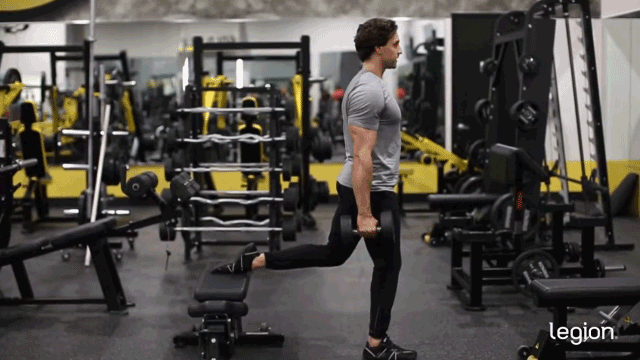
Why: The Bulgarian split squat trains your quadriceps muscle to a high degree, making it an excellent addition to any quad-focused leg day. It’s also beneficial because it trains each leg independently, which helps you build more balanced leg mass.
How to:
- While holding a dumbbell in each hand, stand about 2-to-3 feet in front of a bench with your back to the bench.
- With your right foot planted, place the top of your left foot on the bench behind you.
- Lower your butt toward the floor by bending at your right knee until your right thigh is roughly parallel with the floor.
- Stand up and return to the starting position.
Sets and reps: 3 sets | 4-to-6 reps | 3-to-5 min rest
READ MORE: How to Perform Bulgarian Split Squats for Glutes, Hamstrings & Quad Growth
4. Dumbbell Lunge
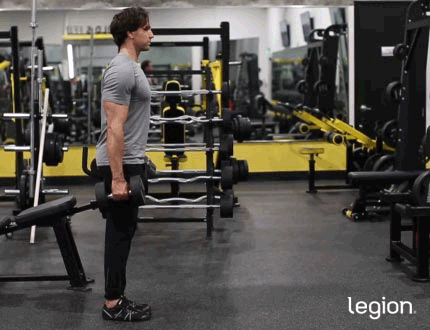
Why: Research shows the dumbbell lunge is a top-tier exercise for building teardrop quads. Because it requires greater balance and coordination than most other leg exercises, it also engages many smaller stabilizer muscles throughout your body, helping you develop full-body mass and strength.
How to:
- Holding a dumbbell in each hand, stand with your feet hip-width apart.
- Take a long step forward with your right foot—about 2-to-3 feet. Bend both knees until your left knee touches the floor.
- Reverse the motion by pushing through your right foot and leaning slightly backward, allowing your legs to straighten.
- Once you’re standing, bring your right foot back to the starting position.
Sets and reps: 3 sets | 6-to-8 reps | 2-to-3 min rest
READ MORE: Dumbbell Reverse Lunge: Muscles Worked, Form & Variations
5. Leg Press
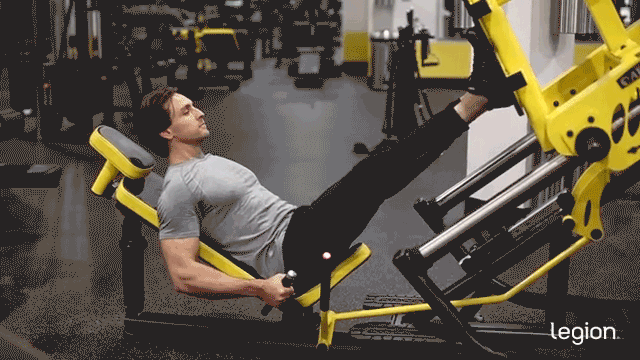
Why: The leg press is an outstanding quad-focused leg day exercise because it lets you use heavier weights than most other quad exercises, which helps you build quad mass fast.
How to:
- Wedge your butt down into the base of the leg press machine seat.
- Place your feet halfway up the footplate a little wider than shoulder-width apart with your toes pointing slightly outward.
- Straighten your knees and use the safety handles to release the weight.
- Lower the footplate toward your torso until your thighs are about 12-to-18 inches from your chest.
- Push the footplate upward until your legs are almost but not completely straight (knees slightly bent).
Sets and reps: 3 sets | 4-to-6 reps | 3-to-5 min rest
READ MORE: How to Do the Leg Press: Benefits, Form, & Alternatives
6. Hack Squat
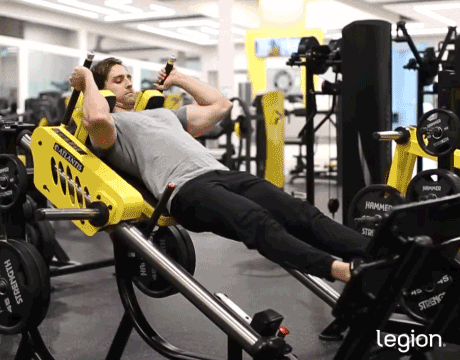
Why: The hack squat is a fantastic compound quad exercise. It’s particularly effective for increasing quad mass because it allows you to lift heavy weights while reducing stress on your knees and back.
How to:
- Position your body so that your feet are shoulder-width apart on the hack squat machine footplate with your toes pointing slightly outward, and your shoulders and back are against the pads.
- Straighten your knees and use the safety handles to release the weight.
- Keeping your back against the pad, sit down and push your knees out in the same direction as your toes.
- Stand up and return to the starting position.
Sets and reps: 3 sets | 4-to-6 reps | 3-to-5 min rest
READ MORE: How to Hack Squat for Leg Mass & Strength
7. Dumbbell Step-up
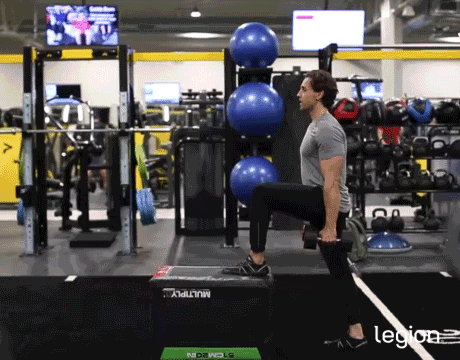
Why: The dumbbell step-up trains your entire lower body, helps eliminate size and strength imbalances, boosts your squat performance, and is easier on your knees and back than many other lower-body exercises. Hence, it’s a fantastic exercise to include in your quad-focused leg day.
How to:
- Holding a dumbbell in each hand, place your right foot on a box, bench, or other surface about knee-height off the floor.
- Keeping your weight on your right foot, fully straighten your right leg.
- Lower your left foot toward the floor, and return to the starting position.
Sets and reps: 3 sets | 6-to-8 reps | 2-to-3 min rest
READ MORE: Weighted Step-Ups Guide: How to Do Dumbbell Step-Ups
8. Dumbbell Split Squat
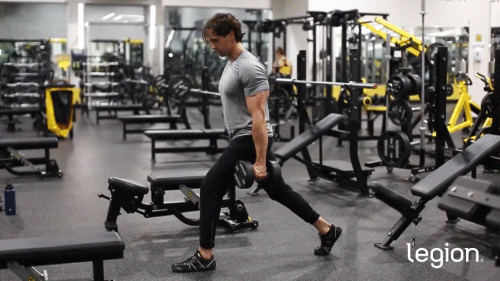
Why: The dumbbell split squat allows you to train all your leg muscles one leg at a time, helping you build balanced mass and strength. Because it’s less dynamic, it also requires less balance and coordination than the lunge, making it a solid addition to a beginner quad-focused leg day.
How to:
- Holding a dumbbell in each hand, stand with your feet about shoulder-width apart.
- Take a long step forward with your right foot—about 2-to-3 feet. Keeping your weight on your front foot, bend both knees until your left knee touches the floor.
- Reverse the motion by pushing through your right heel to straighten your legs and return to the starting position.
- Once you’ve performed the desired number of reps, switch legs and repeat the process.
Sets and reps: 3 sets | 6-to-8 reps | 2-to-3 min rest
READ MORE: Dumbbell Split Squat: Form, Benefits, & Muscles Worked
9. Goblet Squat
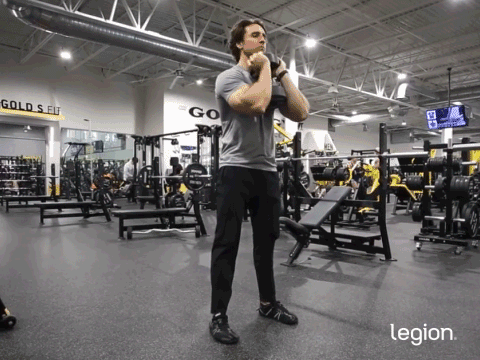
Research shows that the goblet squat is an effective quad exercise and, thus, a valuable addition to any quad-focused leg day workout. Because you hold the weight in your hands rather than across your shoulders, it’s also easier on your back than other free-weight quad exercises.
How to:
- Hold a dumbbell in front of your chest with both hands.
- Place your feet a little wider than shoulder-width apart, point your toes slightly outward, and raise your chest.
- Keeping your back straight, sit down and push your knees out in the same direction as your toes.
- Stand up and return to the starting position.
Sets and reps: 3 sets | 8-to-10 reps | 2-to-3 min rest
READ MORE: Goblet Squat: Form, Form, Muscles Worked, & Common Mistakes
10. Sissy Squat
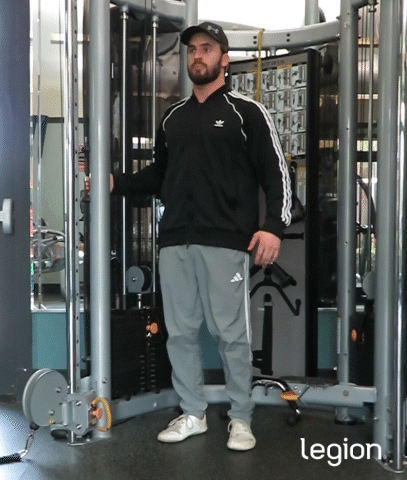
Why: The sissy squat is a highly effective lower quad exercise that you can perform using your body weight. Its main advantage is that it trains your quads through a full range of motion and in a stretched position, which is important for maximizing growth.
How to:
- Stand with your feet shoulder-width apart, holding onto a sturdy object with your dominant hand.
- Squeeze your glutes, then bend your knees, allowing them to move forward over your toes.
- As you descend, let your body lean backward, and your heels come off the floor.
- Lower yourself as far as you comfortably can or until your glutes are 6-to-12 inches from your heels.
- Reverse the movement and return to the starting position.
Sets and reps: 3 sets | 10-to-20 reps | 2-to-3 min rest
READ MORE: How to Do Sissy Squats for Killer Quads
11. Bodyweight Squat
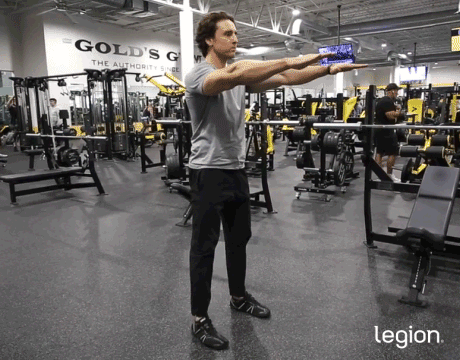
Why: Bodyweight squats are a good quad exercise for people who are new to training or working around an injury, or for those who want to do quad workouts at home.
How to:
- Place your feet a little wider than shoulder width-apart and point your toes slightly outward.
- Reach your arms out in front of you or cross your hands in front of your chest.
- Keeping your back straight, sit down and push your knees out in the same direction as your toes.
- Stand up and return to the starting position.
Sets and reps: 3 sets | 10-to-20 reps | 2-to-3 min rest
12. Leg Extension
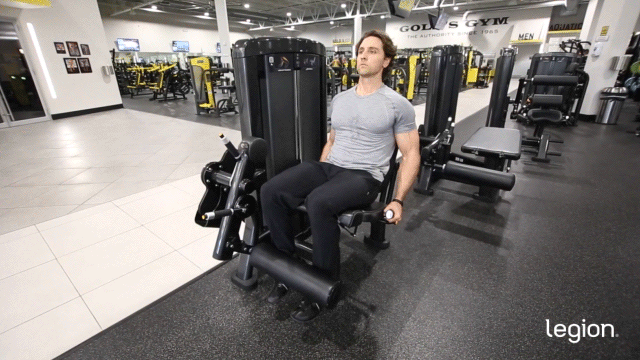
Why: The leg extension is a useful exercise for adding extra volume for your quads at the end of a quad-focused leg day. To make it an even more effective lower quad exercise, set the seat as far back as possible and perform the exercise leaning back. This stretches your quad muscles more, which benefits growth.
How to:
- Sit on the leg extension machine seat and adjust the back pad so your knees are just in front of the edge of the seat.
- Adjust the lower leg pad so it touches your shins right above your ankles and puts your feet as close to your butt as possible.
- Grab the handles and push your feet toward the ceiling, extending your legs until your knees are straight.
- Bend your knees to lower your feet and return to the starting position.
Sets and reps: 3 sets | 10-to-15 reps | 2-to-3 min rest
READ MORE: Leg Extension: Muscles Worked, Alternatives, and Form
The Best Quad-Focused Leg Day Workouts
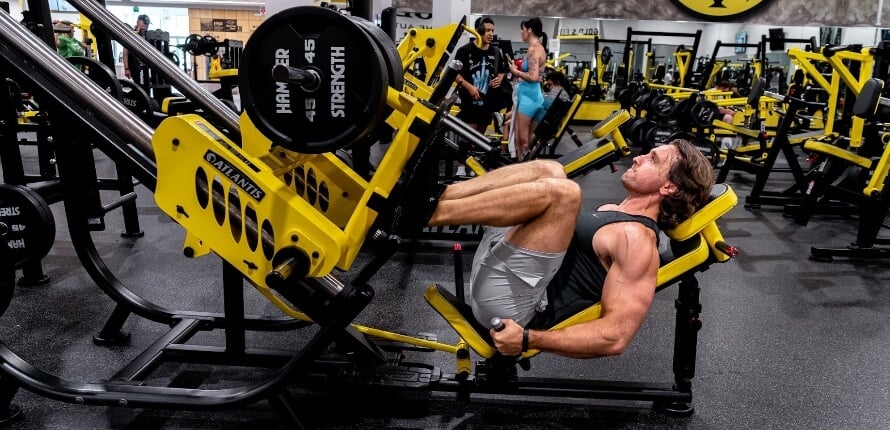
Now that you know the best exercises to build quad mass, it’s time to structure them into an effective quad-focused leg day.
The workouts below combine the top quad strengthening exercises with the right amount of volume and intensity to grow your teardrop quads without burning you out.
For best results, follow Quad-Focused Leg Day #1 once per week for 8-to-10 weeks as part of a well-designed training program. Then, take a deload week and switch to Quad-Focused Leg Day #2 for the following 8-to-10 weeks.
After that, continue alternating between the two, or build your own quad-focused leg day using the exercises listed above.
Quad-Focused Leg Day #1
- Barbell Back Squat: 3 sets | 4-to-6 reps | 3-to-5 min rest
- Leg Press: 3 sets | 4-to-6 reps | 3-to-5 min rest
- Dumbbell Step-up: 3 sets | 6-to-8 reps | 2-to-3 min rest
- Sissy Squat: 3 sets | 10-to-20 reps | 2-to-3 min rest
Quad-Focused Leg Day #2
- Barbell Front Squat: 3 sets | 4-to-6 reps | 3-to-5 min rest
- Hack Squat Press: 3 sets | 4-to-6 reps | 3-to-5 min rest
- Bulgarian Split Squat Step-up: 3 sets | 6-to-8 reps | 2-to-3 min rest
- Leg Extension: 3 sets | 10-to-20 reps | 2-to-3 min rest
Supplements to Maximize Your Quad-Focused Leg Day Results
If you want to accelerate your gains while following the quad-focused leg day routines above, consider these three supplements:
- Protein powder: Protein powder, such as Whey+ (Legion’s whey isolate) or Casein+ (Legion’s micellar casein), provides your body with the nutrients needed to build muscle tissue and recover from workouts.
- Creatine: Creatine boosts muscle and strength gain, improves anaerobic endurance, and reduces muscle damage and soreness from your workouts. For a natural source of creatine, try Legion’s creatine monohydrate, creatine gummies, or post-workout Recharge.
- Pre-workout: A high-quality pre-workout enhances energy, mood, and focus, increases strength and endurance, and reduces fatigue. For a top-tier pre-workout containing clinically effective doses of 6 science-backed ingredients, try Legion’s Pulse with caffeine or without.
(If you’d like even more specific advice about which supplements you should take to reach your health and fitness goals, take the Legion Supplement Finder Quiz, and in less than a minute, you’ll know exactly what supplements are right for you.)
Benefits of Building Bigger, Stronger Quads
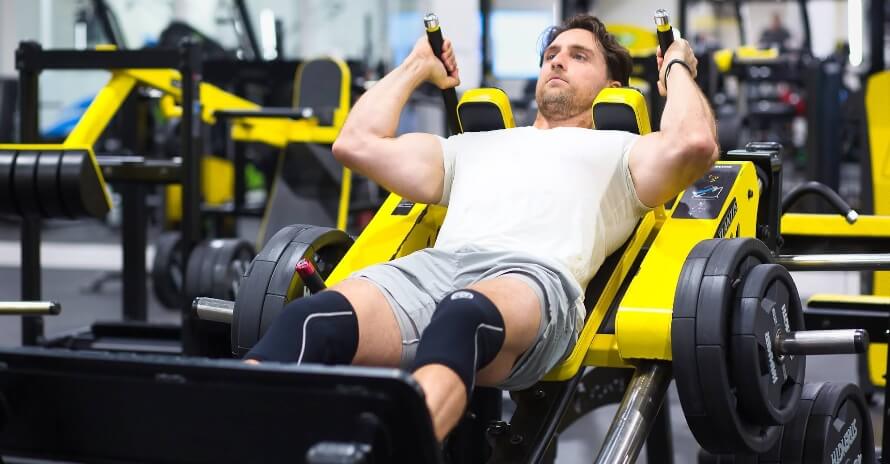
Strong quads do more than just fill out your shorts—they balance your physique, boost athleticism, and make you more resilient to injury.
Improved Aesthetics
Many new weightlifters (and some experienced ones) prioritize training the muscles you can easily see in the mirror: primarily the shoulders, chest, arms, and abs. But they spend comparatively little time training their lower half.
Consequently, they build strong, muscular upper bodies that dwarf their underdeveloped legs.
Thus, a big reason to get bigger quads is to balance your upper and lower body, preventing weak points in your physique.
READ MORE: How to Build the Mathematically Ideal Male Body
Enhanced Athletic Performance
Research shows that having strong quads boosts your power, speed, and strength, which is why it also helps you run faster, jump higher, and move more explosively in almost any sport or physical activity.
Injury Prevention
Many of the best exercises for building your quads enhance lower body stability, which is essential for avoiding injury.
FAQ #1: What is the most effective quad exercise?
The most effective quad exercise for most people is a compound squat variation, like the back, front, or hack squat.
These exercises are generally best for gaining quad size and strength because they train the quads through a full range of motion, allow you to lift heavy weights, and make progressively overloading your quads straightforward.
That said, squats don’t suit everyone. If you find them uncomfortable or awkward, or if you dislike doing them, you can make excellent gains with one of the other exercises listed in this article.
FAQ #2: How do you target all parts of the quads?
The best way to train all parts of your quads is to do a combination of compound squat exercises, like the back, front, and split squat, and isolation exercises that involve straightening your knees, like the leg extension and sissy squat.
Compound squatting is ideal for training the vastus muscles because it allows you to train these muscles through a full range of motion with heavy weights. Free-weight and machine squats also make it easy to progressively overload your quads, which is vital for growth.
However, compound exercises aren’t as effective for training the rectus femoris. Unlike the vastus muscles, the rectus femoris crosses both the hip and knee joints. As a result, it doesn’t stretch or contract much during movements where you move both your hips and knees—like squats.
Isolation exercises, on the other hand, usually keep your hips fixed, which makes them far more effective for targeting the “rec fem,” especially if your hips are extended (your torso and thighs form a near-straight line).
Why not just do isolation exercises, then?
Because these exercises have limited overloading potential—you can’t load them with heavy weights, and it’s harder to add reps or weight over time.
And since increasing mechanical tension is the primary driver of muscle growth, it makes sense to center your training around compound squatting and use isolation exercises to round out your development.
FAQ #3: How do you structure a quad-focused leg day?
You can structure a quad-focused leg day in countless ways, but this simple structure works well for most:
- Exercise #1: A bilateral, free-weight squat variation that allows you to lift heavy weights and progress regularly (e.g., the back, front, or goblet squat).
- Exercise #2: A machine exercise that allows you to continue training your quads with heavy weights without being limited by supporting muscles that may be tired from the first exercises (e.g., the hack squat or leg press).
- Exercise #3: A unilateral free-weight exercise to address any size and strength imbalances you might have (e.g., the Bulgarian or regular split squat, lunge, or step-up).
- Exercise #4: A quad isolation exercise to increase quad volume and better train the rectus femoris (e.g., the leg extension or sissy squat).
FAQ #4: Are 4 exercises enough for a quad-focused leg day?
Yes—doing four exercises on a quad-focused leg day should be enough to accumulate enough volume and train your quads through different ranges of motion and at various angles, both of which are necessary to maximize growth.
FAQ #5: What are the best quad exercises for bad knees?
If you have cranky knees, choose quad strengthening exercises that minimize stress on your knee joints. The five best are:
- Dumbbell step-up
- Goblet squat
- Walking lunge
- Deadlift
- Box squat
To learn more about why these exercises work well and how to do them correctly, check out this article:
5 Safe Squat Alternatives for Bad Knees
Scientific References +
- Kary, Joel M. “Diagnosis and Management of Quadriceps Strains and Contusions.” Current Reviews in Musculoskeletal Medicine, vol. 3, no. 1-4, 2010, pp. 26–31, www.ncbi.nlm.nih.gov/pmc/articles/PMC2941577/pdf/12178_2010_Article_9064.pdf, https://doi.org/10.1007/s12178-010-9064-5.
- Watanabe, Kohei, et al. “Task-Dependent Spatial Distribution of Neural Activation Pattern in Human Rectus Femoris Muscle.” Journal of Electromyography and Kinesiology, vol. 22, no. 2, Apr. 2012, pp. 251–258, https://doi.org/10.1016/j.jelekin.2011.11.004. Accessed 20 Apr. 2020.
- Watanabe, Kohei, et al. “Non-Uniform Surface Electromyographic Responses to Change in Joint Angle within Rectus Femoris Muscle.” Muscle & Nerve, vol. 50, no. 5, 17 Sept. 2014, pp. 794–802, https://doi.org/10.1002/mus.24232. Accessed 26 Feb. 2020.
- Watanabe, Kohei, et al. “Regional Neuromuscular Regulation within Human Rectus Femoris Muscle during Gait.” Journal of Biomechanics, vol. 47, no. 14, Nov. 2014, pp. 3502–3508, https://doi.org/10.1016/j.jbiomech.2014.09.001. Accessed 13 Nov. 2021.
- Watanabe, Kohei, et al. Regional Neuromuscular Regulation within Human Rectus Femoris Muscle during Gait in Young and Elderly Men. Vol. 49, no. 1, 1 Jan. 2016, pp. 19–25, https://doi.org/10.1016/j.jbiomech.2015.11.010. Accessed 12 June 2023.
- Watanabe, Kohei, et al. “Heterogeneous Neuromuscular Activation within Human Rectus Femoris Muscle during Pedaling.” Muscle & Nerve, vol. 52, no. 3, 5 Jan. 2015, pp. 404–411, https://doi.org/10.1002/mus.24544. Accessed 2 Apr. 2020.
- von Laßberg, Christoph, et al. “Longitudinal Sequencing in Intramuscular Coordination: A New Hypothesis of Dynamic Functions in the Human Rectus Femoris Muscle.” PLOS ONE, vol. 12, no. 8, 17 Aug. 2017, p. e0183204, https://doi.org/10.1371/journal.pone.0183204. Accessed 26 June 2022.
- Murray, Nicholas, et al. “Effects of Foot Position during Squatting on the Quadriceps Femoris: An Electromyographic Study.” International Journal of Exercise Science, vol. 6, no. 2, 2013, pp. 114–125, www.ncbi.nlm.nih.gov/pmc/articles/PMC4882472/.
- Martín-Fuentes, Isabel, et al. “Influence of Feet Position and Execution Velocity on Muscle Activation and Kinematic Parameters during the Inclined Leg Press Exercise.” Sports Health: A Multidisciplinary Approach, 4 June 2021, p. 194173812110163, https://doi.org/10.1177/19417381211016357. Accessed 17 Oct. 2021.
- Martín-Fuentes, Isabel, et al. “Muscle Activation and Kinematic Analysis during the Inclined Leg Press Exercise in Young Females.” International Journal of Environmental Research and Public Health, vol. 17, no. 22, 23 Nov. 2020, p. 8698, https://doi.org/10.3390/ijerph17228698. Accessed 30 Dec. 2020.
- Yavuz, Hasan Ulas, et al. “Kinematic and EMG Activities during Front and Back Squat Variations in Maximum Loads.” Journal of Sports Sciences, vol. 33, no. 10, 29 Jan. 2015, pp. 1058–1066, www.growkudos.com/publications/10.1080%25252F02640414.2014.984240/reader, https://doi.org/10.1080/02640414.2014.984240.
- Gullett, Jonathan C, et al. “A Biomechanical Comparison of Back and Front Squats in Healthy Trained Individuals.” Journal of Strength and Conditioning Research, vol. 23, no. 1, Jan. 2009, pp. 284–292, journals.lww.com/nsca-jscr/fulltext/2009/01000/A_Biomechanical_Comparison_of_Back_and_Front.41.aspx, https://doi.org/10.1519/jsc.0b013e31818546bb.
- Jones, Margaret T, et al. “Effects of Unilateral and Bilateral Lower-Body Heavy Resistance Exercise on Muscle Activity and Testosterone Responses.” Journal of Strength and Conditioning Research, vol. 26, no. 4, Apr. 2012, pp. 1094–1100, https://doi.org/10.1519/jsc.0b013e318248ab3b.
- Marchetti, Paulo H., et al. “Balance and Lower Limb Muscle Activation between In-Line and Traditional Lunge Exercises.” Journal of Human Kinetics, vol. 62, no. 1, 13 June 2018, pp. 15–22, content.sciendo.com/view/journals/hukin/62/1/article-p15.xml, https://doi.org/10.1515/hukin-2017-0174.
- Deniz Erdağ, and Hasan Ulaş Yavuz. “Evaluation of Muscle Activities during Different Squat Variations Using Electromyography Signals.” ResearchGate, unknown, 2020, www.researchgate.net/publication/337400852_Evaluation_of_Muscle_Activities_During_Different_Squat_Variations_Using_Electromyography_Signals.
- Simenz, Christopher J., et al. “Electromyographical Analysis of Lower Extremity Muscle Activation during Variations of the Loaded Step-up Exercise.” Journal of Strength and Conditioning Research, vol. 26, no. 12, Dec. 2012, pp. 3398–3405, https://doi.org/10.1519/jsc.0b013e3182472fad.
- Otto, William H., et al. “Effects of Weightlifting vs. Kettlebell Training on Vertical Jump, Strength, and Body Composition.” Journal of Strength and Conditioning Research, vol. 26, no. 5, May 2012, pp. 1199–1202, https://doi.org/10.1519/jsc.0b013e31824f233e.
- Pedrosa, Gustavo F., et al. “Partial Range of Motion Training Elicits Favorable Improvements in Muscular Adaptations When Carried out at Long Muscle Lengths.” European Journal of Sport Science, vol. 22, no. 8, 23 May 2021, pp. 1250–1260, pubmed.ncbi.nlm.nih.gov/33977835/, https://doi.org/10.1080/17461391.2021.1927199.
- Larsen, Stian , et al. The Effects of Hip Flexion Angle on Quadriceps Femoris Muscle Hypertrophy in the Leg Extension Exercise. May 2024, www.researchgate.net/publication/380457955_The_effects_of_hip_flexion_angle_on_quadriceps_femoris_muscle_hypertrophy_in_the_leg_extension_exercise, http://dx.doi.org/10.51224/SRXIV.407.
- Stokes, Tanner, et al. “Recent Perspectives Regarding the Role of Dietary Protein for the Promotion of Muscle Hypertrophy with Resistance Exercise Training.” Nutrients, vol. 10, no. 2, 7 Feb. 2018, p. 180, www.mdpi.com/2072-6643/10/2/180/pdf.
- Eckerson, Joan M., et al. “Effect of Creatine Phosphate Supplementation on Anaerobic Working Capacity and Body Weight after Two and Six Days of Loading in Men and Women.” The Journal of Strength and Conditioning Research, vol. 19, no. 4, 2005, p. 756, https://doi.org/10.1519/r-16924.1.
- Bassit, Reinaldo Abunasser, et al. “Effect of Short-Term Creatine Supplementation on Markers of Skeletal Muscle Damage after Strenuous Contractile Activity.” European Journal of Applied Physiology, vol. 108, no. 5, 3 Dec. 2009, pp. 945–955, https://doi.org/10.1007/s00421-009-1305-1.
- Kirkpatrick, John , and Paul Comfort. Strength, Power, and Speed Qualities in English Junior Elite Rugby League Players. Dec. 2012, www.researchgate.net/publication/233957866_Strength_Power_and_Speed_Qualities_in_English_Junior_Elite_Rugby_League_Players, http://dx.doi.org/10.1519/JSC.0b013e3182804a6d.
- Wisloff, U, et al. “Strong Correlation of Maximal Squat Strength with Sprint Performance and Vertical Jump Height in Elite Soccer Players.” British Journal of Sports Medicine, vol. 38, no. 3, 1 June 2004, pp. 285–288.
- Seitz, Laurent B., et al. “Increases in Lower-Body Strength Transfer Positively to Sprint Performance: A Systematic Review with Meta-Analysis.” Sports Medicine, vol. 44, no. 12, 25 July 2014, pp. 1693–1702.
- Behrens, Matthew J, and Shawn R Simonson. “A Comparison of the Various Methods Used to Enhance Sprint Speed.” Strength and Conditioning Journal, vol. 33, no. 2, Apr. 2011, pp. 64–71, https://doi.org/10.1519/ssc.0b013e318210174d.
- Gallego-Izquierdo, Tomás, et al. “Effects of a Gluteal Muscles Specific Exercise Program on the Vertical Jump.” International Journal of Environmental Research and Public Health, vol. 17, no. 15, 1 Jan. 2020, p. 5383, www.mdpi.com/1660-4601/17/15/5383, https://doi.org/10.3390/ijerph17155383.
- Bartlett, Jamie L., et al. “Activity and Functions of the Human Gluteal Muscles in Walking, Running, Sprinting, and Climbing.” American Journal of Physical Anthropology, vol. 153, no. 1, 12 Nov. 2013, pp. 124–131, https://doi.org/10.1002/ajpa.22419.
- Hartmann, Hagen, et al. “Analysis of the Load on the Knee Joint and Vertebral Column with Changes in Squatting Depth and Weight Load.” Sports Medicine, vol. 43, no. 10, 3 July 2013, pp. 993–1008, www.deepdyve.com/lp/springer-journals/analysis-of-the-load-on-the-knee-joint-and-vertebral-column-with-zkgXYldF90, https://doi.org/10.1007/s40279-013-0073-6.
- “N.S.C.A. POSITION PAPER: The Squat Exercise in Athletic Conditioning: A Position Statement and Review of the Literature.” Strength & Conditioning Journal, vol. 13, no. 5, 1 Oct. 1991, pp. 51–58, journals.lww.com/nsca-scj/Citation/1991/10000/N_S_C_A__POSITION_PAPER__The_Squat_Exercise_in.11.aspx.
- Neumann, Donald A. “Kinesiology of the Hip: A Focus on Muscular Actions.” Journal of Orthopaedic & Sports Physical Therapy, vol. 40, no. 2, 1 Feb. 2010, pp. 82–94, www.jospt.org/doi/10.2519/jospt.2010.3025, https://doi.org/10.2519/jospt.2010.3025.
- Larsen, Stian, et al. “The Effects of Hip Flexion Angle on Quadriceps Femoris Muscle Hypertrophy in the Leg Extension Exercise.” Journal of Sports Sciences, 19 Dec. 2024, pp. 1–12, https://doi.org/10.1080/02640414.2024.2444713.










